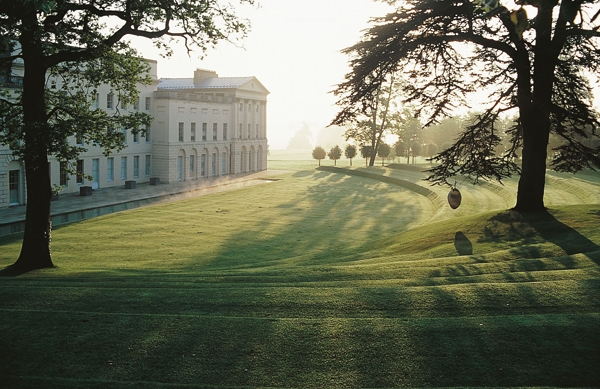The landscape architect Kim Wilkie grew up in a house on the edge of the Malaysian jungle. ‘Things decayed as fast as they grew.’ Leather shoes would fur over with mould within hours if left outside. His father was posted to Iraq next. ‘Everything was brown.’ But stare long enough at the sand and you would see a coin, or a shard of ancient glass. Back home his parents bought the ancient flint and brick farm in Hampshire with which this book ends. Longhorn cattle graze beside the spiral grass mounds which are his best known signature as a designer of parks and gardens.
In the last year of a history degree at Oxford Wilkie discovered that there was such a thing as ‘landscape architecture’. ‘I could hardly believe that everything I loved could be wrapped in one profession: people, land, biology and drawing.’ For this book he has picked 20 design projects, from the restoration of Harold Acton’s Renaissance garden at La Pietra to the elliptical pool cut laser-sharp into the courtyard of the V&A.
The single best-known of his country house schemes is Heveningham Hall in Suffolk, where a scheme plotted by Capability Brown was unexecuted at his death in 1783. JCBs dug the lake Brown plotted on a ten-foot length of paper, while up against the high neo-classical facade Wilkie replaced a Victorian parterre with a grass amphitheatre shaded by holm oaks. (The last credit is to ‘Colin, the genius digger-driver’, whose JCB I imagine pirouetting across the landscape like a cheerful yellow ballerina).
More recently, at Boughton in Northamptonshire, the Duke of Buccleuch took Wilkie up the grass pyramid which is the centrepiece of the half-mile Baroque landscape scored out by Charles Bridgeman in the 1720s but never finished. ‘What would you do with this?’ Why not dig down? A upside down ziggurat seven metres deep was dug as a mirror image of Bridgeman’s pyramid, with a 275-metre grass path (Orpheus meets Escher) descending into a pool which mirrors the sky. It is a work of genius.
You could call Wilkie ‘Britain’s greatest sculptor’ but that is to underestimate the value of the work. This is the first book since Geoffrey Jellicoe’s Landscape of Man (1975) to remind us that landscape design reaches further, deeper and higher than the fine arts. Divided into sections on water and soil, life and spirit, Led by the Land shows how the designer must understand not just geometry and form but also ecology, agriculture and where to put a house.
Above all, the landscape designer works with a fourth dimension: time. He must watch the winter tracks of animals, and the movement of light from hour to hour or season to season — and, finally, life and death, as in an epic scheme for a new cemetery for east London.
Pages of designs are intercut with the author’s photographs of landscape, from neolithic stone rings to the Sovloki monastery in northern Russia; the suggestion is that the best design is an extraction of a character buried in the landscape. The stony glint of the Sovloki monks’ islands on the rim of the Arctic Circle is echoed in the hardness of Wilkie’s imprint. It’s tough, sinewy stuff.
At Shawford in Hampshire a helipad and polo pitch were not wanted by the new owner of the park. The land was parted to the water table of the river Itchen to create a mounded quilt of sheep and wild flowers. When the mists rise, the Antony Gormley figure which stands on the edge shrinks to the meekness of a meerkat.
In just one project does the language shorten its assertive stride: Chelsea Barracks. That’s the site, of course, where a hi-tech glass hive for occasional oligarchs was shelved after a controversial intervention by the Prince of Wales. The new scheme proposes streets and squares, with at the centre a vegetable garden 100 metres in length and watered by Archimedes screws. Will it happen? Chelsea Barracks is the latest battleground in a century-old contest between the ‘green and the grey’: nature, fecundity and life versus mass-engineered packing cases. If Wilkie’s project takes root, it will offer an alternative vision for our cities.
This book made me want to be a landscape architect. Give it to any godchild in their last year at university. It could be the dominant profession of the future. And you might get to have a go on Colin’s digger.






Comments